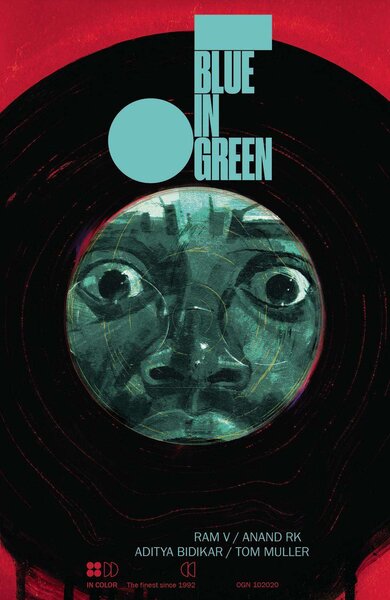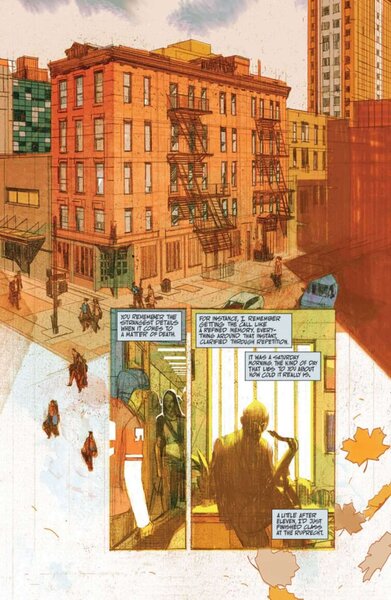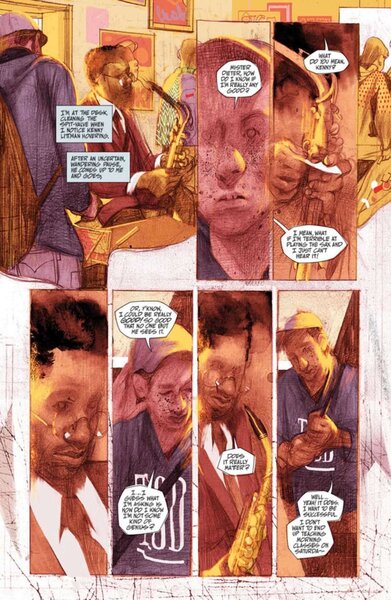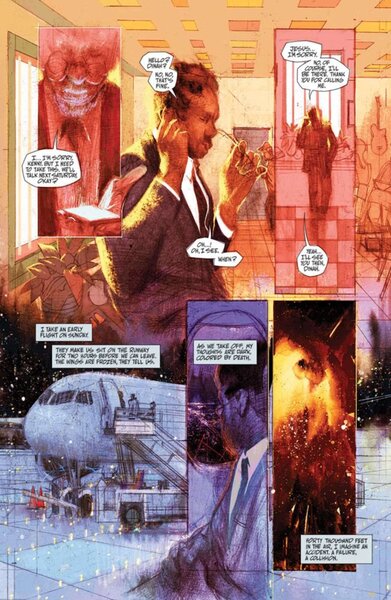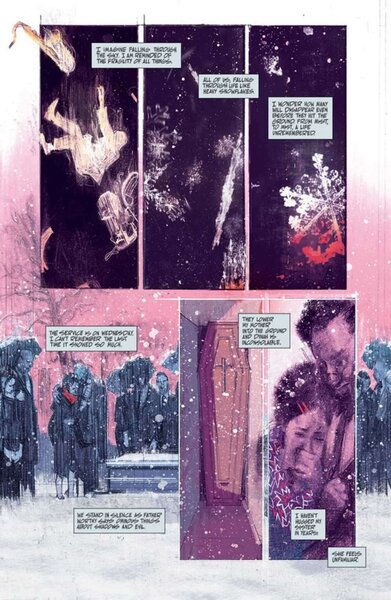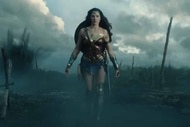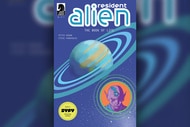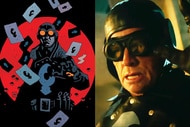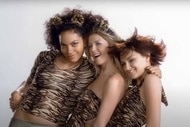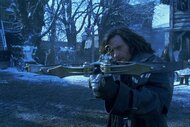Create a free profile to get unlimited access to exclusive videos, sweepstakes, and more!
Indie Comics Spotlight: Blue in Green is a gorgeous exercise in improvisational jazz and horror
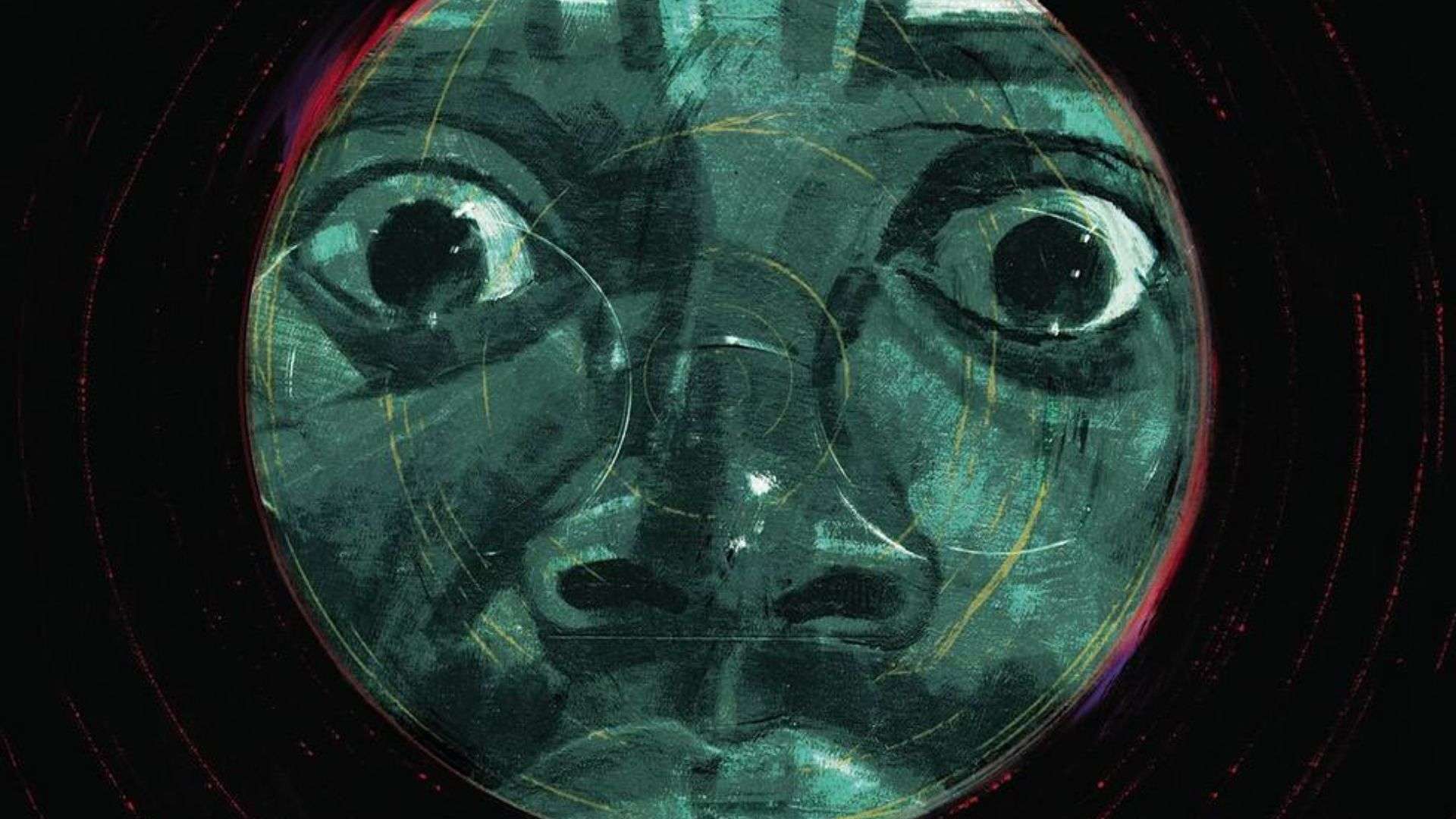
Blue and Green, the upcoming horror graphic novel from writer Ram V (Paradiso, These Savage Shores, Grafity’s Wall) and artist Anand RK (Grafity’s Wall), is about a jazz musician who becomes possessed by a deadly muse. But the story isn’t just a cautionary tale of a lonely musician’s “deal with the devil.” The project, like good jazz, is an example of improvisational storytelling. You see, not a single word of the 152-page trade was outlined. Neither Ram nor Anand knew what they were working on until their daily virtual “jam sessions” to decide where the story should go next.
The title, taken from the 1959 Miles Davis album of the same name, is an example of Ram’s love of the music genre. It’s a love that comes directly from his father, who maintained an eclectic music collection of over 600 cassette tapes in their home in Tawny, a small town outside of Mumbai, India. Jazz was Ram's favorite. As a child growing up, his father would often make him stop what he was doing, turn off the lights in the room, and sit and listen to different artists before discussing the composition of songs with him. The soundtrack to these impromptu music theory lessons were a mix of Art Blakey, Nat King Cole, and Ray Charles, and it's where Ram learned the beauty of improv.
Creating an entire story without an outline or clear vision of the plot might seem like the stuff of editorial nightmares, but this team’s artistic relationship is built on respect and trust. Having known each other since the beginning of Ram’s comic book career, when Anand created the impasto-style cover to Ram’s first international comic, Black Mumba. It took some convincing to get the traditional portrait painter to collaborate on drawing and coloring the award-winning Grafity’s Wall (Dark Horse), which set a precedent for the team’s Blue in Green collaboration.
Ram is a chameleon when it comes to storytelling. He’s just as comfortable writing Catwoman and Justice League Dark as he is creating tremendous indie steampunk worldbuilding stories like Paradiso. As part of the uber-talented collective White Noise, he and his British compatriots (including Alex Paknadel, Dan Watters, Ryan O’Sullivan, and Caspar Wijngaard) have created some incredible stories, including Ram's vampire tale flipped on its head, These Savage Shores (Vault).
But Blue in Green, at its core, is a straightforward story. Eric Dieter, a frustrated musician turned teacher, travels home for his mother’s funeral and uncovers a past that he is not ready to accept, nor fully able to comprehend. The monster, like all good music, is open to interpretation. Is the old saxophone that he finds in his mother’s study a cursed object? Or is the fiend he finds at the bottom of a rabbit hole of depression and loneliness brought to the surface by fears personified? SYFYWIRE spoke with Ram to discuss, and find out how you collaborate on a story when you have no idea where it’s going.
Please explain how you were able to collaborate on a project this size without an outline!
Ram V: It was literally us getting together each morning, going, "Okay, this is the previous page. I have looked at it. And now I think this is what the next page needs to be." So every ensuing page is in reaction to whatever he drew on the previous page.
That’s a scary way to drive, isn’t it? Not knowing which direction you’re going?
Absolutely. I mean, Aditya Bidikar, who was the letterer on the project and is also my "agony aunt" and my confession box, will tell you the number of times I went to him and I went, "I have no idea if this story works because I haven't seen it as a single finished thing yet, because I have only been writing it one page at a time. So I don't know, with the bigger picture of it, [if] it's working." And bless him. Every conversation was saying, "It's fine, Ram. It works."
Did you go back every so often and adjust pages after you created the story?
No, no, there was no going back to pages, because I mean, you can't go back when you’re improvising in music either. So if you're playing and you hit a sequence of notes, that's it, it's there and you can't go back.
Jazz seems to be the only thing that Erik is really close to in this story. He struggles with relationships and his family and his past, is that the real monster?
There's a lot of tension there. Things that have obviously happened in his past play a role into what we get into the story. We're also talking about intergenerational trauma in this book. But I think in some ways music is a metaphor for that, because if you think about Miles Davis’ Blue in Green, since that first composition came out, there are so many versions of it. And each version is haunted by the original song in their own way. I thought that was a really nice concept.
I thought that was an interesting thing to play with in terms of: Okay, who are these people, and how do their generations affect them? How did his parents affect him? How did their parents affect them? It becomes a way of kind of getting into a greater conversation about how we look at music and musicians and their roles in society. Especially jazz and the role that it played in American history.
When Erik first meets the specter, it asks him if he plays music, and then it asks him if it hurts. What is the connection in this story between art and pain?
There is a Charlie Parker quote about jazz that says, “If you don't live it, it won't come out your horn.” That is really the heart of the conversation in the book. I think anyone who's ever tried to be artistic or create something has asked themselves this question of: Have I sacrificed enough to have this gift? Have I given up enough to be gifted in some way?
What about us, as the audience that derives pleasure from that pain?
Either way, it's a failure of society to watch someone create beautiful things and not care about their well-being and their health and their prosperity. Look at van Gogh as an example, right? He was there. He was literally crying out to everyone, “I'm going to die. I'm not doing well. I'm troubled.” And all people wanted was for him to sell his paintings.
We've lost so many, so many great artists, you know, Kurt Cobain, Chet Baker, and Charlie Parker ... take all of these artists who have suffered through depression and isolation and difficulties. So all it does is heighten our appreciation of their music. But no one ever wonders: Why did we allow this to happen in the first place? Therein lies the specter, right?
In These Savage Shores, you redefined who the monster was. In Blue in Green, are you redefining the muse?
I'm questioning rather than redefining. Even with These Savage Shores, I wouldn't say I redefined. I would say maybe I asked the question: “What if the thing that you think is the monster is not quite the monster you thought it was?” I suppose the question that I'm asking here is, “What if the thing that you thought was talent and artistic genius and brilliance is not quite the thing you thought it was?”
The horror in this book is often juxtaposed with things of beauty, why did you choose to handle it that way?
I think that's just my idea of horror, to be honest. I like the kind of horror where you look at something and you go, "Oh my God, that's gross," "That's disgusting," or "That's terrible!" But I much prefer the horror that you can't articulate, but it makes you feel uneasy for some reason.
Did your improv collaboration extend to coloring the work with John Pearson well?
I think John and Anand really gelled because John's fundamentally a painter to begin with, as well. So they spoke the same language. Although the colors are by John, and the vast majority of the work on these pages is John, I would also be remiss if I didn't say that Anand also had a hand in the look. Anand takes John’s pages, goes away, and does some kind of secret magic. Every time the pages come back, I'm just like, “What did you do? That looks amazing.” And John has said the same thing. So it’s definitely a collaboration.
There are so many incredible panels in the book, what’s one of your favorites?
There are a couple in there, but one of my favorites is at his mother’s house after the funeral, Eric picks up a saxophone that his mother has kept, that used to belong to him, and he begins to play. This other character that he's kind of had a crush on comes in and asks him what he’s playing. And he says, “I'm playing a song called ‘Danny's Dream’ by Lars Gullin." If you look at the way the panels are placed, that's actually the bass notes from "Danny's Dream" [as they would appear on sheet music].
I can't wait for people to see how music and aesthetic are interwoven with visual art in this book.
Blue in Green comes out on paperback Nov. 3, but you can pre-order your copy now.
